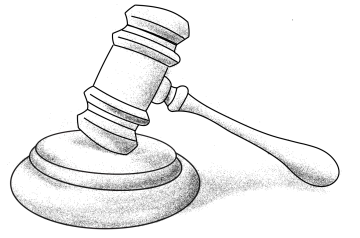Wildcat Changemakers
University alumni and faculty make an impact

Discover the wonder at the heart of each and every one of us — driving us to do the extraordinary.
The University of Arizona has always been a place where innovation and innovative people thrive: Our researchers follow their curiosity to meaningful discoveries. Our students have launched businesses in between classes. And our graduates are prepared to bring their ingenuity to communities around the world. “Innovation ecosystems are driven by universities like ours,” says Betsy Cantwell, UArizona senior vice president for research and innovation. “It’s almost always universities where new ideas get turned into something.”
Shaping Metals
by Paul Tumarkin and Sarah Beaudry
Flying high above the clouds are thousands of satellites that help scientists learn about Earth and the solar system. Satellites predict weather patterns and climate trends, and they ensure our televisions and phones get a signal from most places on Earth.

Algae
by The College of Engineering
When we think of algae, we might think of descriptors like “murky,” “slippery,” “gooey” and “green.” Not necessarily “rich in molecules ideal for sustainability.”

But at the University of Arizona, researchers are using environmentally sustainable microalgae products to create vaccines and health supplements. And they have invented a process to produce microalgae and other microorganisms at low cost and industrial-scale rates: the Air Accordion Photobioreactor.
UArizona biosystems engineering professor Joel Cuello and his team developed the new technology, which Tech Launch Arizona is helping them bring to the world.
“Commercialization of my ‘bioimagineering’ team designs is the culminating capstone for our research endeavors — enabling our innovations to be applied to create value for all stakeholders in society, including the general public,” Cuello says. “It makes our work so impactful and rewarding.”
Bioreactors are used to grow yeast, bacteria and algae as well as plant and mammalian cells to manufacture antibodies and vaccines. Conventional bioreactors for microalgae use long tubes, pipes or columns and even panels made of glass. They are typically expensive to manufacture, and they often fall short in maintaining the mixing characteristics needed for industrial-scale production.
The Air Accordion Photobioreactor features a zigzag configuration, a departure from conventional bioreactors, and is made of a low-cost polyethylene material. It is designed with hydrodynamic properties that promote the optimal growth of microorganisms while maximizing water and nutrient efficiency.
Upcoming product trials for the Air Accordion will focus on producing health supplements such as omega-3 fatty acids and spirulina. UArizona research partners include the College of Agriculture and Life Sciences, the College of Engineering and the B
Howl-itosis
by Eddie San Juan
University of Arizona researchers have developed a harmless bacteria strain to battle bad breath in our furry friends.

When administered orally, the additive produces a minty aroma that improves dogs’ breath. Eric Lyons developed the technology with co-inventor David Baltrus. Both are associate professors in the College of Agriculture and Life Sciences.
“The applications of the invention are vast,” Lyons says. “Our plan is that they will eventually find a home among all sorts of pet treats, food and oral care products.”
Lyons and Baltrus are working to improve the duration efficacy of the product up to eight or 12 hours and want to develop other scent offerings. They developed the strain by screening hundreds of bacteria found in dog mouths, identifying 20 that were harmless and easy to modify. They synthesized DNA constructs, encoding enzymes for producing mint or pear smells, and put those genetic programs into the selected bacteria, choosing the ones that worked best for further development and optimization.
With help from Tech Launch Arizona, Lyons and Baltrus co-founded a startup, uPetsia, together with business development professional Scott Zentack.
Tech Launch Arizona provided services to refine and protect the intellectual property, as well as technology development funding and mentorship. The startup team licensed the technology from the university in March to take it forward into the market.
The University of Arizona Center for Innovation, the university’s incubator at the Tech Park at Rita Road, recently accepted the startup into its program to help entrepreneurs develop and scale their operations.
uPetsia is now doing product trials and working with industry partners to develop methods to integrate the technology into existing pet foods and snacks.
Vision Health
by Mikayla Mace
As we age, we all face the natural evolution of changing health, including vision.

The proteins that must be precisely structured to create the eye’s transparent lens can clump, causing cataracts. The routine solution for nearly 50 years has been to surgically remove the natural lenses and replace them with artificial intraocular lenses. However, those lenses are unable to focus at all distances, requiring users to wear glasses or contacts.
In the 1990s, bifocal intraocular lenses became available. But the bifocal lens design offers clarity for only two distances: near and far.
University of Arizona optical sciences professor Jim Schwiegerling has designed implantable cataract replacement lenses that also correct mid-range vision and may eliminate the need for glasses or contacts for some people.
“Here’s how it works,” Schwiegerling explains. “There’s this technology called ‘diffractive lenses’ that look a little like mini lighthouse lenses — instead of a smooth curve, the lens has little steps. If you alternate steps of different heights, you can create this third focus to use for computer distance.”
With support from Tech Launch Arizona, the university filed patents for the invention to protect the intellectual property, and then licensed the technology to global medical device company Alcon.
Alcon incorporated Schwiegerling’s technology in its novel trifocal intraocular lens, PanOptix, launched in Europe in 2015. In summer 2019, the last two major countries — the United States and Japan — approved use of the new lenses.
Schwiegerling developed cataracts several years ago. But, he says, because PanOptix wasn’t yet available in the U.S., he traveled to Germany to get them implanted for himself.
“So I’m a user and not just a maker,” he says. “I am thrilled with being able to do my outdoor activities, work at the computer and read without being encumbered by glasses. I see like I am young again.”
Critical Thinking
by Emily DieCkman and Katy Smith
David Ashton ’13 uses the problem-solving skillsets he acquired while earning a University of Arizona systems and industrial engineering bachelor’s degree daily. However, Ashton is not just an engineer, he practices patent law for a nationally recognized intellectual property law firm.

“I couldn’t be happier with my decision to go to the University of Arizona — or with my career,” says Ashton, who obtained a master’s degree in engineering and a Juris Doctor from Texas Tech University in 2017.
Ashton secures domestic and international IP protection for businesses with innovative technologies in the fields of semiconductors, engineered optics, displays and manufacturing. His time is split between deeply diving into engineering concepts with inventors, advising clients on the business and legal implications of cases, and providing legal analysis. And by doing so, he provides clients with the expertise and value needed to achieve their business goals.
Ashton’s innovative career path began in high school during a scholars’ program about engineering disciplines.
Everything clicked when an attorney told the students about IP law, and he decided the field could unite his interests in technology and business.
He chose Arizona because, he says, “It looked like it would provide the foundation to becoming a critical thinker.”
The knowledge Ashton acquired from his engineering education is invaluable, he says.
“Learning to think in a systematized, organized approach will always help you to be the best possible attorney, even as technology continues to change.”
Green Architecture
by Angie Smith and Simmons Buntin
Landscape architecture wasn’t on the horizon for Kendra Hyson ’15 when she graduated in 2011 from Spelman College, an all-women’s historically Black college in Atlanta. However, the seed may have been planted when she participated in an art residency in Panama the summer before her senior year.

Hyson was inspired by the “people, culture and scenery of Panama,” where she created environmental installation art. Afterward, Hyson came to the College of Architecture, Planning and Landscape Architecture intending to study sustainable tourism.
“But after starting the program,” she says, “I became interested in community-based design, and particularly designing with — instead of only for — people.”
After graduating and joining the Neighborhood Design Center in Prince George’s County, Maryland, Hyson discovered a calling for community engagement and began to consider the social and political implications of designs.
In 2017, Hyson joined the board of directors for the Landscape Architecture Foundation as the Olmsted Scholar’s representative. LAF brings landscape architects together to pursue sustainability and social justice through the profession.
She credits that appointment in part to being named the 2015 University Olmsted Scholar for UArizona. Olmsted Scholars is an LAF program that supports students with exceptional leadership potential. Hyson’s board term was influential in her co-founding of The Urban Studio, a nonprofit organization.
The Urban Studio is run by landscape architects of color who aim to halt the historical system of development happening in communities of color without consideration of the people who live in those communities.
“Our mission is to advance design thinking for equitable and sustainable urbanism,” she says. “That is something we united around — addressing the problems that result in displacement and gentrification while also creating a model for mentorship and transformational leadership.”
Designing Human
by Angie Smith and Simmons Buntin
When Dyron Murphy ’88 began studying architecture at the University of Arizona, the environment was unfamiliar to him.

“I moved from Window Rock on the Navajo Nation to Tucson in 1982. It was a huge change, and walking onto campus was mind-blowing. Where I was raised, there wasn’t always a sense of urgency, and I realized very early on that I needed to get busy,” he says.
Murphy formed close relationships with his classmates, with whom he remains in touch, and he found that the curriculum prepared him to cultivate flexibility. For example, when Murphy was in college, everything was drawn by hand. When CAD came about, he was able to apply hand-drawing skills in combination with the technology. He believes using the two together makes him a stronger architect.
Murphy would need that willingness to grow shortly after graduating. At one of his first design jobs in Albuquerque, New Mexico, he was asked to help with marketing and client work in the owner’s extended absence. This was challenging with no experience, but Murphy found success in putting together proposals and winning commissions — and eventually realized he could run his own firm.
He started Dyron Murphy Architects PC in 2001. The Albuquerque firm’s priority is infusing local culture with contemporary architecture principles. Murphy and his associates strive to help people through architecture and planning for “the human factor” — looking at how end users experience their environments and designing accordingly.
Murphy designed his most memorable project, the Navajo Tribal Utility Authority building in Fort Defiance, New Mexico, in 2019. In the summer of 1985, while still in college, he had interned at NTUA and worked on a design concept for the building.
When it went out to bid decades later, Murphy’s firm was selected.
“I knew a lot of people who were still working for NTUA, and they remembered me from that summer internship,” he says.
Streaming Service
by Sarah Beaudry
In 1949, Norman Rockwell painted “The New Television Set.” It depicts the joyous owner of a new TV smiling at a man installing the antenna. In Rockwell’s signature style, it captures a moment: an entire story in a single storyboard.

How would Rockwell portray television today, and who would be in the painting? We consume content on more media platforms and devices than ever before. Binge-watching is a popular pastime. And we can access stories and characters from cultures around the world, at any time. The gleeful gent from 1949 had no idea how good TV could get.
Streaming services like Netflix, Amazon, Apple and even YouTube continue to disrupt the media landscape, and the pandemic added to the congestion.
“The year 2020 brought more disruption,” said Andrew Schulz, dean of the University of Arizona College of Fine Arts. “At the heart of it is the rapidly evolving media landscape.”
Schulz talked about media disruption with a panel of alumni and faculty, including Scott Stuber, during a Wonder at Home Webinar last year. Stuber oversees global film at Netflix. Before that, he spent 20 years at Universal Studios working in traditional film production. Stuber shared his thoughts on the evolution of media and its backbone — good storytelling.
“It is the ability to choose a story well,” he said. “At the end of the day, it’s the same storytelling it’s always been … back to cave drawings. Can you move someone with the narrative you’re telling?”
Perhaps Rockwell would have agreed.
At UArizona, Stuber took classes in the history of film, film theory and screenwriting. He left for Los Angeles worried he might never land a gig. But once he made it to the table, he said, he had the education and grit needed to make it.
“You can run around at 19 and make a movie,” he said. “But it doesn’t necessarily make you understand narrative structure. I understood how to tell a story, and my education helped.”
He also loved the art of filmmaking. During the webinar, he shared his account of industry changes through the years.
“When I started, film and television were very different mediums. Film was the predominant medium. Television was something every Tuesday night on CBS. And it didn’t have the artistry, depth or production value,” he said.
Then the golden age of television dawned. HBO, Netflix and Amazon created a new brand of television that included rich storytelling, detailed narrative and complex characters.
“Shonda Rhimes started in film. Vince Gilligan, who did ‘Breaking Bad.’ Matt Weiner, who did ‘Mad Men.’ These shows defined the last decade, where writers who didn’t feel like their verbiage was appreciated in film migrated to TV and found more authorship,” Stuber said.
Stuber was part of it all, offering a place for artists to tell diverse stories. When he took the job at Netflix, he said, he saw a real opportunity. “We had nothing. No IP, no library to remake ‘Nutty Professor.’ There was a real opening for original.”
Looking back to 2017, Netflix continued to disrupt the entertainment industry. “We’re continuing to make big entertainment for audiences around the globe, and making films with more diversity in front of and behind the camera.”
It used short but award-qualifying theatrical runs for movies such as Bong Joon-ho’s “Okja” and Dee Rees’ “Mudbound,” which received four Academy Awards nominations. In 2018, the Netflix-backed Alfonso Cuarón film “Roma” sparked controversy when it won Oscars for Best Director, Best Foreign Language Film and Best Cinematography.
The debate: Should streaming films that show in theaters for less than a week qualify for Academy Awards?
“In the beginning, people thought, ‘They’re going to ruin the movie business,’” Stuber said. “The irony is, when you move away the distribution model and you ask who is hiring the most people — grips, camera people, editors, actors, directors — Netflix, Amazon, Apple has been a savior for the artist, the crew member, the talent that can tell a different story and work in a vibrant industry.”
Stuber, who said he’s a proud Wildcat, has a message for UArizona students.
“I can’t wait to see what all of you do. You’re going to be a generation of incredible filmmakers. You’re going to be a generation that helps evolve the world through storytelling.”
Watch the Wonder at Home series to catch up with alumni Scott Stuber and Brad Slater — giving.arizona.edu/wonder-home
